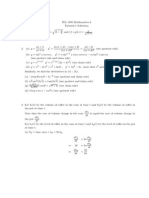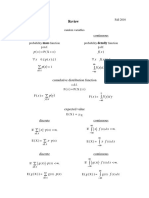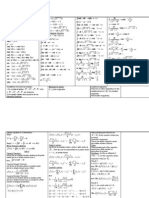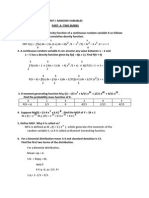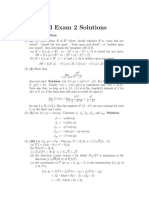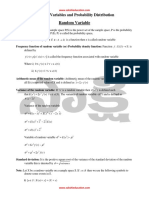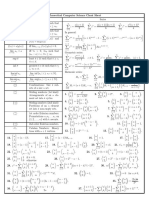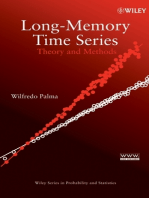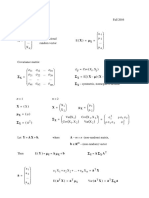N Be A Random Sample From The Distribution
N Be A Random Sample From The Distribution
Uploaded by
dCopyright:
Available Formats
N Be A Random Sample From The Distribution
N Be A Random Sample From The Distribution
Uploaded by
dOriginal Title
Copyright
Available Formats
Share this document
Did you find this document useful?
Is this content inappropriate?
Copyright:
Available Formats
N Be A Random Sample From The Distribution
N Be A Random Sample From The Distribution
Uploaded by
dCopyright:
Available Formats
STAT 410
1.
Let > 0 and let X 1 , X 2 , , X n be a random sample from the distribution
with the probability density function
f ( x; ) = 2 2 x 3 e x ,
2
a)
Find E ( X k ), k > 4.
x > 0.
Consider u = x 2 or u = x 2.
( a ) = u a 1 e u du , a > 0.
Hint 1:
Hint 2:
E( Xk) =
x k 2 2 x 3 e x dx
2
u = x2
du = 2 x
u 2
=
0
=
k 2
+1
du =
k 2
k
2
+1
e u du
+ 2 .
2
OR
E( Xk) =
x k 2 2 x 3 e x dx
2
u = x2
du = 2 x
=
2
+1
e u du
k 2
2
1
k
+ 2
2
0 k
+ 2
since
1
k
+ 2
2
+2
+1
+2
+1
e u du = k 2
+ 2 ,
2
k
e u is the p.d.f. of Gamma ( = + 2 , =
2
).
b)
Obtain a method of moments estimator of , .
That is, if E ( X ) = h ( ), solve X = h ( ) for .
Suppose n = 5,
x 1 = 0.6, x 2 = 1.1, x 3 = 2.7, x 4 = 3.3, x 5 = 4.5.
and
Find a method of moments estimate of .
E( X ) =
1 2
3
5
1 2 3
1 2
1
+ 2 =
=
2 2
2
1 2
= X
x 1 = 0.6,
~
1 =
( )
~
1 =
( )2
16 X
x 2 = 1.1,
16 x
1
1 2 3 1
=
2 2
2
3 1
2 2
x 3 = 2.7,
x 4 = 3.3,
x 5 = 4.5.
x =
12.2
= 2.44.
5
0.09448 0.29682.
OR
E( X2) =
= X
2 2
2
1
2
.
+ 2 = ( 3 ) = 1 2 ! =
X i2
n
i =1
~
2 =
2
X2
2n
n
Xi
i =1
x 1 = 0.6,
~
2 =
x 2 = 1.1,
2n
n
x i2
i =1
x 3 = 2.7,
= 0.25.
x 4 = 3.3,
x 5 = 4.5.
x i2
i =1
= 40.
c)
Obtain the maximum likelihood estimator of , .
That is, find = arg max L ( ) = arg max ln L ( ),
where L ( ) =
f ( xi ; ) .
i =1
Suppose n = 5,
and
x 1 = 0.6, x 2 = 1.1, x 3 = 2.7, x 4 = 3.3, x 5 = 4.5.
Find the maximum likelihood estimate of .
L( ) =
2 2 x i3 e
x i2
i =1
( )
ln L ( ) = n ln 2 + 2 n ln + ln x i3 x i2 .
i =1
( ln L ( ) )' =
n
x i2 = 0.
i =1
2n
i =1
2n
n
X i2
i =1
x 1 = 0.6,
=
2n
n
x 2 = 1.1,
x i2
i =1
= 0.25.
x 3 = 2.7,
x 4 = 3.3,
x 5 = 4.5.
x i2
i =1
= 40.
d)
What is the probability distribution of W = X 2 ?
Let W = X 2
fW(w ) = fX(v(w )) | v'( w) | = 2 2 w3
=
e)
( 2 )
w 21 e
v'( w) =
W = v(W )
X=
ew
1
2 w
1
2 w
= 2 we
w > 0.
W has Gamma ( = 2, =
) distribution.
n
What is the probability distribution of Y = X i2 ?
i =1
Suppose X and Y are independent, X is Gamma ( 1 , ), Y is Gamma ( 2 , ).
If random variables X and Y are independent, then M X + Y ( t ) = M X ( t ) M Y ( t ).
1
M X + Y( t ) =
X + Y is Gamma ( 1 + 2 , );
i =1
X i2 =
i =1
( 1 t ) 1 ( 1 t ) 2
( 1 t ) 1 + 2
W i has Gamma ( = 2 n, =
) distribution.
t<
f)
Suppose = 0.2. Find P ( X > 5 ) = P ( X 2 > 25 ).
Hint:
If T has a Gamma ( , = 1 ) distribution, where is an integer, then
F T ( t ) = P ( T t ) = P ( Y ) and P ( T > t ) = P ( Y 1 ),
where Y has a Poisson ( t ) distribution.
W = X 2 has Gamma ( = 2, =
) distribution.
P ( X > 5 ) = P ( X 2 > 25 ) = P ( W > 25 )
= P ( Poisson ( 0.2 25 ) 1 )
= P ( Poisson ( 5 ) 1 )
= 0.040.
g)
Suppose = 0.2. Find P ( 3 < X < 4 ).
Hint:
If T has a Gamma ( , = 1 ) distribution, where is an integer, then
F T ( t ) = P ( T t ) = P ( Y ) and P ( T > t ) = P ( Y 1 ),
where Y has a Poisson ( t ) distribution.
W = X 2 has Gamma ( = 2, =
) distribution.
P ( 3 < X < 4 ) = P ( 9 < W < 16 ) = P ( W > 9 ) P ( W > 16 )
= P ( Poisson ( 0.2 9 ) 1 ) P ( Poisson ( 0.2 16 ) 1 )
= P ( Poisson ( 1.8 ) 1 ) P ( Poisson ( 3.2 ) 1 )
= 0.463 0.171 = 0.292.
h)
n
Suppose n = 5 and = 0.2. Find P ( X i2 < 35 ).
i =1
If T has a Gamma ( , = 1 ) distribution, where is an integer, then
Hint:
F T ( t ) = P ( T t ) = P ( Y ) and P ( T > t ) = P ( Y 1 ),
where Y has a Poisson ( t ) distribution.
X i2
has Gamma ( = 2 n, =
i =1
X i2
) distribution.
has Gamma ( = 10, = 5 ) distribution.
i =1
n
P ( X i2 < 35 ) = P ( Gamma ( = 10, = 5 ) < 35 )
i =1
= P ( Poisson ( 0.2 35 ) 10 ) = 1 P ( Poisson ( 7 ) 9 )
= 1 0.830 = 0.170.
i)
Suppose = 0.2. Find P ( 1.10 < X < 4.41 ).
Hint:
If T has a Gamma ( , = 1 ) distribution, where is an integer, then
2T
= 2 T has a 2 ( 2 ) distribution ( a chi-square distribution with
2 degrees of freedom ).
W = X 2 has Gamma ( = 2, =
) distribution.
P ( 1.10 < X < 4.41 ) = P ( 1.2100 < W < 19.4481 )
= P ( 2 0.2 1.2100 < 2 ( 4 ) < 2 0.2 19.4481 )
= P ( 0.484 < 2 ( 4 ) < 7.77924 ) = 0.90 0.025 = 0.875.
j)
Suppose = 0.2. Find a such that P ( X 2 < a ) = 0.10.
Hint:
If T has a Gamma ( , = 1 ) distribution, where is an integer, then
2T
= 2 T has a 2 ( 2 ) distribution ( a chi-square distribution with
2 degrees of freedom ).
W = X 2 has Gamma ( = 2, =
) distribution.
P ( X 2 < a ) = P ( W < a ) = P ( 2 ( 4 ) < 2 0.2 a ) = 0.10.
02.90 ( 4 )
0.4 a =
a = 2.66.
2.66 1.63095.
= 1.064.
k)
Suppose = 0.2. Find b such that P ( X > b ) = 0.05.
Hint:
If T has a Gamma ( , = 1 ) distribution, where is an integer, then
2T
= 2 T has a 2 ( 2 ) distribution ( a chi-square distribution with
2 degrees of freedom ).
W = X 2 has Gamma ( = 2, =
) distribution.
P ( X > b ) = P ( X 2 > b 2 ) = P ( W > b 2 ) = P ( 2 ( 4 ) > 2 0.2 b 2 ) = 0.05.
0.4 b 2 =
b =
02.05 ( 4 )
= 9.488.
23.72 4.87032.
l)
n
Suppose n = 5 and = 0.2. Find c such that P ( X i2 < c ) = 0.01.
i =1
Hint:
If T has a Gamma ( , = 1 ) distribution, where is an integer, then
2T
= 2 T has a 2 ( 2 ) distribution ( a chi-square distribution with
2 degrees of freedom ).
X i2
has Gamma ( = 2 n, =
i =1
X i2
) distribution.
has Gamma ( = 10, = 5 ) distribution.
i =1
n
n
P ( X i2 < c ) = P ( 2 0.2 X i2 < 2 0.2 c ) = P ( 2 ( 20 ) < 0.4 c ) = 0.01.
i =1
i =1
02.99 ( 20 )
0.4 c =
c = 20.65.
= 8.26.
m)
n
1
Let Y = X i2 . Find E (
Y
i =1
X i2
Y =
E(
Xi
Hint: Recall part (e).
has Gamma ( = 2 n, =
i =1
i =1
Wi
).
1
= E(
Y
) distribution.
2 n 2 n1 x
dx
x
e
x ( 2n )
i =1
2 n1 2 n2 x
.
=
x
dx =
e
( 2n 1) 0 ( 2n 1)
2n 1
n)
Is the maximum likelihood estimator of , , an unbiased estimator of ?
If is not an unbiased estimator of , construct an unbiased estimator of
based on .
2n
E ( ) = E (
Y
2n
.
= +
2n 1
2n 1
is NOT an unbiased estimator of .
Consider
2n 1
2n 1
.
=
=
n
2n
2
Xi
i =1
Then
2n 1
E ( ) =
E ( ) = .
2n
o)
Find MSE ( ) = E [ ( )
E[(
x2
( bias ( ) ) 2 + Var ( ).
2 n 2 n1 x
dx
x
e
( 2n )
( 2 n 1 )( 2 n 2 )
2
( 2 n 1 )( 2 n 2 )
1
Var ( ) = 4 n 2 Var (
Y
2n 1
bias ( ) = E ( ) =
1 2
) ]=
Y
2 n2
x 2 n3 e x dx
( 2n 2 )
2
2
= 4n 2
( 2 n 1 )( 2 n 2 ) ( 2 n 1 ) 2
4n 2 2
( 2n 1 ) 2 ( 2n 2 )
MSE ( ) = ( bias ( ) ) 2 + Var ( ) =
(4 n 2 + 2 n 2 ) 2
( 2n 1 ) 2 ( 2n 2 )
4n 2 2
2
+
( 2n 1 ) 2 ( 2n 1 ) 2 ( 2n 2 )
( 2n + 2 ) 2 .
( 2 n 1 )( 2 n 2 )
You might also like
- Solutions To Steven Kay's Statistical Estimation BookDocument16 pagesSolutions To Steven Kay's Statistical Estimation Bookmasoudsmart67% (3)
- MA1505 Tutorial Solution 1Document6 pagesMA1505 Tutorial Solution 1Bilguun BatboldNo ratings yet
- Bivariate Normal 1 With Answers PDFDocument22 pagesBivariate Normal 1 With Answers PDFdNo ratings yet
- X K U X U X A: N Be A Random Sample From The DistributionDocument13 pagesX K U X U X A: N Be A Random Sample From The DistributiondNo ratings yet
- RaoCramerans PDFDocument10 pagesRaoCramerans PDFdNo ratings yet
- Expectation: Definition Expected Value of A Random Variable X Is DefinedDocument15 pagesExpectation: Definition Expected Value of A Random Variable X Is DefinedLibyaFlowerNo ratings yet
- Review1 PDFDocument22 pagesReview1 PDFdNo ratings yet
- DX Dy y X F W: IndependentDocument13 pagesDX Dy y X F W: IndependentdNo ratings yet
- Chebyshev's Inequality:: K K K KDocument12 pagesChebyshev's Inequality:: K K K KdNo ratings yet
- STAT 330 Extra Problems - Chapters 1 To 5Document6 pagesSTAT 330 Extra Problems - Chapters 1 To 5Matt WangNo ratings yet
- hw3 SolDocument8 pageshw3 SolanthalyaNo ratings yet
- International Competition in Mathematics For Universtiy Students in Plovdiv, Bulgaria 1995Document11 pagesInternational Competition in Mathematics For Universtiy Students in Plovdiv, Bulgaria 1995Phúc Hảo ĐỗNo ratings yet
- MA1102RSoln1 (Partial)Document3 pagesMA1102RSoln1 (Partial)Anonymous t4uG4pFdNo ratings yet
- Solutions To Problems: X 0 ZX X yDocument19 pagesSolutions To Problems: X 0 ZX X yrohitvanNo ratings yet
- FormDocument6 pagesFormBruno AmorosoNo ratings yet
- Sopum 2013: Funkcije IzvodniceDocument9 pagesSopum 2013: Funkcije IzvodniceJoван ПоплашенNo ratings yet
- EE585 Fall2009 Hw3 SolDocument2 pagesEE585 Fall2009 Hw3 Solnoni496No ratings yet
- Detailed Solutions A-07 JUNE 2003: I X X F F IDocument32 pagesDetailed Solutions A-07 JUNE 2003: I X X F F IAdzLinkBalaoangNo ratings yet
- A Class of Third Order Parabolic Equations With Integral ConditionsDocument7 pagesA Class of Third Order Parabolic Equations With Integral ConditionsArmin SuljićNo ratings yet
- Wχ f F FDocument7 pagesWχ f F FKarl Stessy PremierNo ratings yet
- 2.3 Conditional Distributions and Expectations. 1Document9 pages2.3 Conditional Distributions and Expectations. 1dNo ratings yet
- Multivariable Calculus, 2009-10-30. Per-Sverre Svendsen, Tel.035 - 167 615/0709 - 398 526Document5 pagesMultivariable Calculus, 2009-10-30. Per-Sverre Svendsen, Tel.035 - 167 615/0709 - 398 526lieth-4No ratings yet
- Calculus 1 List of ExercisesDocument8 pagesCalculus 1 List of Exercisesp1tru1mariusNo ratings yet
- X X X X Ecx Ecx: Tan - Sec Sec Cot - Cos CosDocument4 pagesX X X X Ecx Ecx: Tan - Sec Sec Cot - Cos Cossharanmit2039No ratings yet
- Solutions To Fall 2006 Math 301 Midterm Problems: N M 1 N NDocument4 pagesSolutions To Fall 2006 Math 301 Midterm Problems: N M 1 N NJacky PoNo ratings yet
- N Be A Random Sample From The DistributionDocument2 pagesN Be A Random Sample From The DistributiondNo ratings yet
- FALLSEM2020-21 MAT2001 ETH VL2020210101181 Reference Material I 05-Aug-2020 MGF CFDocument6 pagesFALLSEM2020-21 MAT2001 ETH VL2020210101181 Reference Material I 05-Aug-2020 MGF CFPrajesh KumarNo ratings yet
- Functions of Random Variable Answers PDFDocument12 pagesFunctions of Random Variable Answers PDFdNo ratings yet
- Problem Set 2Document8 pagesProblem Set 2سام النعمانNo ratings yet
- Invariant density estimation. Let us introduce the local time estimator (x) = Λ (x)Document30 pagesInvariant density estimation. Let us introduce the local time estimator (x) = Λ (x)LameuneNo ratings yet
- Unit 1 - 03Document10 pagesUnit 1 - 03Raja RamachandranNo ratings yet
- Calculus 3 Exam 2 SolutionsDocument2 pagesCalculus 3 Exam 2 Solutionsjackson leachNo ratings yet
- Solutions Manual To: An Introduction To Mathematical Finance: Options and Other TopicsDocument65 pagesSolutions Manual To: An Introduction To Mathematical Finance: Options and Other TopicsHanh VuNo ratings yet
- M5A42 Applied Stochastic Processes Problem Sheet 1 Solutions Term 1 2010-2011Document8 pagesM5A42 Applied Stochastic Processes Problem Sheet 1 Solutions Term 1 2010-2011paradoxNo ratings yet
- M-Tech 1 Year Cace Lab Computational LabDocument41 pagesM-Tech 1 Year Cace Lab Computational LabGowri ShankarNo ratings yet
- Text Book: Barrante, 3rd, 2004.: Applied Mathematics For Physical ChemistryDocument38 pagesText Book: Barrante, 3rd, 2004.: Applied Mathematics For Physical ChemistryTzung-Ying YangNo ratings yet
- N Highest Value M M MDocument31 pagesN Highest Value M M MGOWTHAMNo ratings yet
- Solution To Practice Problems For Test 2Document6 pagesSolution To Practice Problems For Test 2Kuldeep KushwahaNo ratings yet
- Problems AnswersDocument15 pagesProblems Answersanand singhNo ratings yet
- Eli Maor, e The Story of A Number, Among ReferencesDocument10 pagesEli Maor, e The Story of A Number, Among ReferencesbdfbdfbfgbfNo ratings yet
- Ee132b Hw2 SolDocument4 pagesEe132b Hw2 SolDylan LerNo ratings yet
- Exam - 2013 10 30Document5 pagesExam - 2013 10 30lieth-4No ratings yet
- X X X F X F X F X: Likelihood FunctionDocument12 pagesX X X F X F X F X: Likelihood FunctiondNo ratings yet
- Sol 6 Fall 04Document9 pagesSol 6 Fall 04Daniel Cervantes CabreraNo ratings yet
- Gamma Distribution, - Distribution, Student T-Distribution, Fisher F - DistributionDocument6 pagesGamma Distribution, - Distribution, Student T-Distribution, Fisher F - DistributionrodgedogNo ratings yet
- 09 Random Variables and Probability DistributionsDocument16 pages09 Random Variables and Probability DistributionsKishore GurramNo ratings yet
- MATH 300 Fall 2004 Advanced Boundary Value Problems I Solutions To Sample Final Exam Friday December 3, 2004Document6 pagesMATH 300 Fall 2004 Advanced Boundary Value Problems I Solutions To Sample Final Exam Friday December 3, 2004tehepiconeNo ratings yet
- Lecture 12Document2 pagesLecture 12Tanu DixitNo ratings yet
- Random Samples: Definition A Statistic Is Any Function of Observations From ADocument18 pagesRandom Samples: Definition A Statistic Is Any Function of Observations From ALibyaFlowerNo ratings yet
- 12 International Mathematics Competition For University StudentsDocument4 pages12 International Mathematics Competition For University StudentsMuhammad Al KahfiNo ratings yet
- Statistics 116 - Fall 2004 Theory of Probability Practice Final # 2 - SolutionsDocument7 pagesStatistics 116 - Fall 2004 Theory of Probability Practice Final # 2 - SolutionsKrishna Chaitanya SrikantaNo ratings yet
- TheoreticalCS CheatsheetDocument10 pagesTheoreticalCS Cheatsheetmaile4scribdNo ratings yet
- Assignment (Ch-Continuity & Differentiabilty)Document15 pagesAssignment (Ch-Continuity & Differentiabilty)sheetalNo ratings yet
- Guidelines of The Answer!: X X X XDocument3 pagesGuidelines of The Answer!: X X X Xsidik17No ratings yet
- Fall 2013 Math 647 Homework 5Document9 pagesFall 2013 Math 647 Homework 5gsmarasigan08No ratings yet
- Mathematics 1St First Order Linear Differential Equations 2Nd Second Order Linear Differential Equations Laplace Fourier Bessel MathematicsFrom EverandMathematics 1St First Order Linear Differential Equations 2Nd Second Order Linear Differential Equations Laplace Fourier Bessel MathematicsNo ratings yet
- Analytic Geometry: Graphic Solutions Using Matlab LanguageFrom EverandAnalytic Geometry: Graphic Solutions Using Matlab LanguageNo ratings yet
- F X X X U: SufficientDocument4 pagesF X X X U: SufficientdNo ratings yet
- Review2 PDFDocument3 pagesReview2 PDFdNo ratings yet
- Multivariate Normal PDFDocument5 pagesMultivariate Normal PDFdNo ratings yet
- N Be A Random Sample From The DistributionDocument2 pagesN Be A Random Sample From The DistributiondNo ratings yet
- Functions of Random Variable Answers PDFDocument12 pagesFunctions of Random Variable Answers PDFdNo ratings yet
- Functions of Random Variable PDFDocument6 pagesFunctions of Random Variable PDFdNo ratings yet
- Convergence and Large Sample Approximations - Part 1 Definition: Convergence in DistributionDocument10 pagesConvergence and Large Sample Approximations - Part 1 Definition: Convergence in DistributiondNo ratings yet
- X X X F X F X F X: Likelihood FunctionDocument12 pagesX X X F X F X F X: Likelihood FunctiondNo ratings yet
- X X X X: Otherwise 0 0 1 0 0 0Document6 pagesX X X X: Otherwise 0 0 1 0 0 0dNo ratings yet
- Convolution1 PDFDocument2 pagesConvolution1 PDFdNo ratings yet
- Chebyshev's Inequality:: K K K KDocument4 pagesChebyshev's Inequality:: K K K KdNo ratings yet
- 2.3 Conditional Distributions and Expectations. 1Document9 pages2.3 Conditional Distributions and Expectations. 1dNo ratings yet
- CLT PDFDocument4 pagesCLT PDFdNo ratings yet
- Chebyshev's Inequality:: K K K KDocument12 pagesChebyshev's Inequality:: K K K KdNo ratings yet
- Bivariate Normal Distribution:: X y X FDocument4 pagesBivariate Normal Distribution:: X y X FdNo ratings yet
- 410Hw02 PDFDocument3 pages410Hw02 PDFdNo ratings yet
- 2.3 Conditional Distributions and ExpectationsDocument6 pages2.3 Conditional Distributions and ExpectationsdNo ratings yet

